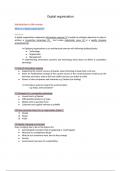Digital organization
Introduction to the course
What is a digital organization?
Definition
A digital organization implements information systems (1) to realize its strategic objectives in order to
achieve a competitive advantage (2). And create stakeholder value (3) in a rapidly changing
environment (4)
⇒ Digitizing organizations is an architectural exercise with following building blocks:
● Technology
● Organization
● Management
⇒ Implementing information systems and technology alone does not deliver a competitive
advantage
(1) Role of information systems
● Supporting the current course e.g Ryanair uses technology to keep their costs low
● Driver for fundamental change of the current course or the current business model e.g in the
old times you had to order a dvd from netflix now you can watch it online
● Source of new companies and industries e.g Cambio (car trading)
⇒ Information systems impact the world and jobs.
e.g DeepL and translators?
(2) Strategies for a competitive advantage
● Lowest cost e.g Ryanair
● Differentiated product e.g Tesla
● Market niche e.g protein food
● Customer and supplier intimacy e.g Netflix
(3)Three important things for an organization (triple P)
1) People
2) Planet
3) Profit
(4) Rapidly changing environment
Every company has to be on the lookout for:
● technological innovation that is happening or could happen
● What are our competitors doing?
● What do our customers want, how do they change
● Society
● Government (new laws for sustainiblity)
,Chapter 1: Information systems in global business today
How are information systems transforming business, and why are they so essential for
running and managing a business today?
Information Technology Capital Investment
IT capital investment grew 12 percent (21→ 33) of
all invested capital between 1999 and 2017
Industrial revolution
Ingredients of an industrial revolution
1) Technological innovation
2) Transformation of the ‘way of working’ (impacting management methods, working condition,
job content, organization of work etc)
3) Transformation of the ‘way of living’ (impacting customer requirement, lifestyle, society,
planet)
First industrial revolution
● Steam power, mechanization, weaving loom
● Factories with machines
● Urbanization
● Increase in productivity
● Gas lighting (producing when it’s dark)
● Hard working conditions
● Pollution was born
,Second industrial revolution
● Electricity
● Production lines
● Mass production (standardization)
● Taylorism (scientific management)
● Railroads
● Global sales
● Human robots
Third industrial revolution
● Automation (robotics)
● Digitalization (computers, internet)
● Lean management (self-steering teams, job autonomy)
● Reduction of manual work (new skills)▪ Improved ergonomics
● Globalisation & e-commerce (competition for job, resources, ideas)
● Offshore production (drastic reduction of costs of operating and transacting on global scale)
Fourth industrial revolution
● Internet of Things (everything is connected to the internet)
● Big data
● AI and machine learning
● Cloud computing
● Blockchain
● AR/VR/XR/Metaverse
● 5G
● Cybersecurity
● 3D printing
● Autonomous robots
● Digital twins
● Simulation
→ Cyber physical production systems (influence of internet of Things on manufacturing)
1) Operator does everything based on his own experience
2) The AI algorithms help the operator to do things better
3) Everything talks to each other and we don’t have human intervention anymore
New business models because of the fourth revolution
Personalization
Because mass production is possible the cost of a customized product is the same as the
cost of a non customized product.
Servitization
Definition = Servitization is the transformation of a business to compete through a
combination of services and products, rather than products alone. E. g Hp ink
Platform business model
Definition = A business model that uses technology to connect people, organization and
resources in an interactive ecosystem in which high value can be created and exchanged.
, Is there already a fifth revolution?
⇒ The transition to a sustainable (1), humancentric (2) and resilient (3) European industry
(1) limits of the planet, emission, energy, water,..
(2) wellbeing, safety, empowerment, skills, war for talent,..
(3) Covid19, Ukraine war, climate change,.. (the process needs to be adaptable to crisis)
No, there is not a fifth revolution because the same technology as in the fourth revolution is being
used.
Productivity paradox
Why did the shift from steam power to electrical power take that long?
Because they used the electricity for the steam machine so it was basically the same way of working,
it started changing when they started connecting the electricity to the machines individually.
What is an information system? How does it work? What are its management, organization,
and technology components? Why are complementary assets essential for ensuring that
information systems provide genuine value for organization?
What is an information system?
Definition = An information system can be defined as a set of interrelated components that collect,
process, store and distribute information to support decision making and control in an organization.
Information <> data
● Data are streams of raw facts representing events occurring in the organization
● information is data shaped into meaningful, useful form
Activities in an information system
● Input: captures raw data (internal or external)
● processing: converts raw data into meaningful form
● output: Transfers processed information to support decision-making
● feedback: output returned to appropriate members of the organization to help them evaluate
or correct the input stage.
Dimensions of Information Systems
→ Using information systems effectively requires an understanding of the organization, management,
and information technology shaping the systems.
● Organizations (1)
● Management (2)
● Technology (IT) (3)
→ Management information systems tries to achieve broader information
system literacy.




